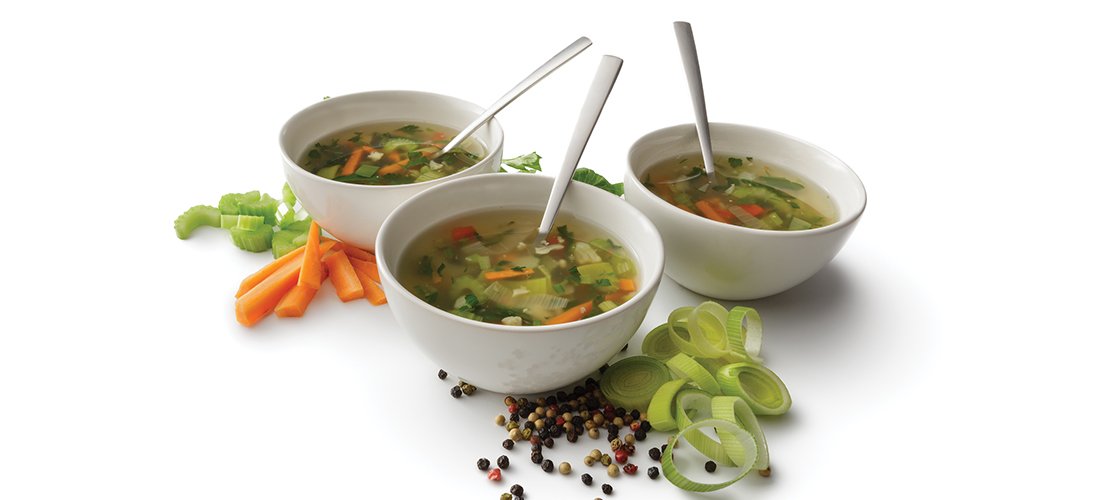
Soup’s On!
Take the chill off the Ides of March
By Jan Leitschuh
On the cusp of spring, when the weather swings wildly between balmy hope and savage bluster, every kitchen gardener senses a good pot of soup is warranted.
A well-made soup is fine home medicine to chase off the crud. The ultimate comfort food, a big pot of soup can nourish an ailing body for days. It goes down easy. It’s a spring tonic and a spring cleanse all in one.
“My European mother would make soups and it would fill us up,” says Goldie Toon, former chef and owner of Goldie’s Gourmet in West End. Among her loyal patrons, Toon was known as the Soup Queen for her popular, bubbling pots of specialty soups. “People would order quarts of it at a time,” she recalls.
Soup is efficient. A well-balanced soup is a meal in itself; just add a crust of bread, a jug of wine and thou. Stuff veggies, protein, flavorful stock and spices — everything you need — in a pot and heat ’er up! Invite friends.
Say you can’t cook? Au contraire. You can make soup. Everyone can make soup. And with a Crock-Pot, the soup hardly needs watching.
“Last night’s leftovers make the next day’s soup,” says Toon. “In fact, that’s probably how soup got started.” Her cafe’s three most popular soups were a luxurious shrimp and crab bisque, a hearty beef barley, and a gingered curried carrot.
After a couple of hours turning up the spring soil in anticipation of planting lettuces, radishes, spinach, beets, carrots, kale, arugula and other crops that germinate in cold soil, a body craves soup for lunch. A hearty cup will take the chill off those “in like a lion” March days. It’s a cozy accompaniment to seasonal seed catalog perusal.
With the new planting season commencing, it’s time to clean out the freezer and canning jars of last year’s bounty anyway. Toss in those last two jars of canned green beans. Dump the frozen sweet corn into a bacony chowder or a Brunswick stew. You’ll need the room; by the end of the month, the fresh asparagus will be arriving.
Crafting a batch couldn’t be easier. It can be a recipe-free, creative endeavor.
Start with stock. It’s the “juice” in which you will simmer the remaining ingredients; it’s the element that ties it all together.
All grandmas know chicken soup is good for the crud, as well as the soul. Purists will want to simmer chicken thighs until the meat is falling off the bone, then strain and pick the meat, returning it to the pot. Simmering the bones gets tissue-building collagen and minerals into your home medicine. Same with a meaty beef bone, turkey carcass or ham hock. Others may opt to simply open a quart of chicken or beef broth. Bone broth is increasingly available in cartons these days, too. Vegans can opt for a rich vegetable stock. You can even use plain water, although the richness factor is harder to re-create.
Now, chop up a batch of onions — the more the better. Is there any savory recipe that doesn’t begin with “sauté an onion?” It is our flavor bass note. Packed with nutrients, full of the kinds of elements our healthy gut biome loves, onions also have antibacterial properties. Sauté in butter or olive oil. A little browning increases the flavor profile of your upcoming soup.
What next?
Though you will add many of them a little later, consider: What do you enjoy most? Italian spices? Curry flavors? A spicy Mexican soup? An Asian twist? Simple meat-and-potatoes salt and pepper?
Whatever you choose, think about adding multiple cloves of garlic. Used medicinally for 5,000 years, garlic has antibiotic, atherosclerotic and anti-cholesterol properties. It helps lower blood pressure. Hippocrates, the father of Western medicine, prescribed garlic for respiratory problems, parasites, poor digestion, and fatigue. It tastes good. It runs off vampires. I rest my case.
You might choose to add sinus openers such as cayenne pepper or fresh ginger. Cayenne warms things up and juices the winter-sluggish metabolism. Besides its wonderful bite and zing, ginger is anti-inflammatory and wards off nausea and muscle aches. Gingerol, the bioactive substance in fresh ginger, can help lower the risk of infections and inhibit the growth of many different types of bacteria. Ginger has been shown to speed up emptying of the stomach in people with indigestion.
You might toss in a little turmeric, another potent anti-inflammatory and antioxidant, especially with a chicken soup base.
As for vegetables, it depends on what you have on hand or can pick up easily. Here is a free-form “recipe” we make several times each winter because it’s cheap, easy, tasty and a wholesome meal in itself — chicken garlic cabbage soup, with lots of garlic.
In a big Crock-Pot, dump in sautéed onion, chicken and stock. Cabbage is inexpensive and nutritious, so it forms the bulk. I like to chop it fine, as if I was making spring rolls or coleslaw, but anyway you hack into a head is OK.
Start tossing in what you have or what you like: sliced mushrooms, those baby carrots that are so convenient, lots of celery, that cauliflower “rice” you find in the stores these days, chopped asparagus, perhaps some broccoli florets, and, of course, more garlic. Season with salt and pepper, a teaspoon or more of curry powder, a pinch of cayenne, a little ginger. Heat until carrots are softened (microwaving them first is a trick that speeds up cooking time). Just before eating, we’ll add a little soy sauce and a dash of toasted sesame oil. It will make you sit up and bark for joy.
Remember all those little tubs of kale you froze when it was in season? Use them up. If you didn’t, there is plenty of fresh kale in the market now. That leads us to another fine winter soup, a simple white bean, sausage and kale. This soup starts out much the same: Sauté some onions in olive oil or butter. Throw in lots of garlic. Chop up the kale and sauté briefly. How much kale? Dial your dose. Italian sausage is a good addition. Dump it in the Crock-Pot (or a soup pot, but beans love to burn in a soup pot, so watch closely). Add a quart or more of chicken stock, depending on how many you plan to feed. Dump in a can or two of white (cannellini) beans. A trick for a thick, chowdery bean soup is to hold back some beans and process them in a blender, adding the bean slurry back into the soup. Season with salt and pepper, perhaps some Italian spices.
A good, all-American corn chowder could be your third free-form option. Chowder is a classic cold-weather soup. Sauté up some bacon, then remove from the pan and sauté some onions in the drippings. In the pot, throw in some small-diced potatoes, chopped celery, some chopped carrots for color, and several cups of sweet corn kernels. Add three or four cups of milk, though a vegan friend does hers with almond milk (she also skips the bacon, sautéing in olive oil). Take care not to boil the milk. Soup is ready when the potatoes soften. To give it a nice thickness, mash some of the potatoes. Add lots of salt and pepper.
And, if you prefer a more formal recipe . . .
Goldie’s Curried Carrot Soup
1 tablespoon olive oil
3 pounds carrots, peeled and chopped
1 large onion, chopped
1 tablespoon shredded ginger
1 1/2 teaspoons curry powder
1 teaspoon salt
6 cups water
1/2 cup orange juice
Juice of one lime
Can of coconut milk
In a large pot, sauté onion in olive oil until soft. Stir in carrots, ginger, curry powder, salt. Add water, bring to a boil, then reduce and simmer 20 more minutes until carrots are soft. Add in orange juice, lime and coconut milk. Purée, then return to pot. Check for seasoning. Serves 6-8. Can be served hot or cold. PS
Jan Leitschuh is a local gardener, avid eater of fresh produce and co-founder of Sandhills Farm to Table.





